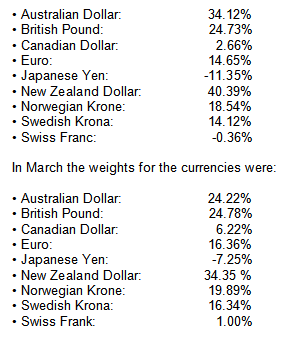Forex Trader Top 3: UK Banks Stingy, Subprime Hits Euro Bank and S&P Currency Arbitrage Index Rebalanced
Mark Whistler is the founder of www.WallStreetRockStar.com and is the author of multiple books on trading. Mark’s newest book, The Swing Trader’s Bible – co-authored with CNBC/Fox News regular guest Matt McCall – will be on shelves in late summer, 2008. In addition, Mark also writes regularly for TraderDaily.com and Investopedia.com.
Sign up for a free trial to Forex Force with Mark Whistler, a twice-daily alert service from professional trader Mark Whistler featuring intraday and swing trading setups. Click here to start your free trial.
1. Killing Cable through Banking Greed
The News:
At 4:30 AM this morning, UK Net Lending numbers hit the market, driving “cable” (the floor name for the pound) spiraling downward. The news shows that despite the Bank of England cutting rates three times in the last six months, greedy banks aren’t lowering rates for would-be borrowers.
The Breakdown
Overall, UK net lending decreased from 9.8 billion pounds in February to 8.2 billion pounds in March. Month over month net lending to consumers declined 0.6%.
What is important to note is that as of February, the BOE has cut rates twice, since November of 2007, with the average effective rate for consumers at 5.88% in February, above the 5.25% rate at that time.
Clearly UK banks are becoming increasingly stingy with their cash, as seen in not passing rate cuts through to consumers.
After the news was announced at 4:30 AM EST, cable fell through the floor against the U.S. dollar, falling roughly 160 PIPs from the announcement, as of 7:30 AM this morning. Tuesday will be interesting, to see if cable is able to recover lost ground from liquidity concerns. Â
The Bottom Line:
Clearly, banking reform is needed not only within the UK, but the United States as well. When central banks hike rates, banks usually increase their lending rates for businesses and consumers almost immediately; however, when it comes to lowering rates, the cuts take significant time to trickle through to those borrowing money. At the end of the day, the fact that liquidity to consumers is hampered through higher-than-necessary lending rates, will only hamper economic growth through real-estate, consumer, and business lending. Greedy banks hamper economic growth.
Â
2. Euro Zone Not Immune to Subprime
The News
Deutsche just wrote down $4.2 billion in the first three months of 2008 – based on US mortgage issues.
The Breakdown
Even Euro-Banks aren’t immune to the subprime debacle, as seen in fresh write downs at Deutsche, Germany’s largest bank. The subprime losses mean the bank will take its first loss in five years. What’s more, according to the BBC, the losses would have been much worse if the company hadn’t sold chunks of large investments, like automaker Daimler.
What we’re seeing is the subprime issues trickling into the Euro Zone through US and UK subprime exposure. While the Euro Zone itself is yet to report direct subprime issues – apart from those abroad – when banks take large losses, they tighten up business and lending, which will only crimp liquidity in the Euro Zone going forward.
Despite elevated inflation, the ECB will eventually have to cut rates to keep liquidity and GDP growth afloat in Europe.
The Bottom Line
While the euro may make one last run at a move higher – liquidity news from Europe (prompting the ECB to lower rates in the future) means the mighty euro could be over the hill.
Â
3. S&P Rebalances Currency Arbitrage Index
The News:
Effective on the close Monday evening, S&P 500 rebalanced the Currency Arbitrage Index, with the close value at 507.364, with the volatility modifier for the index at 0.94628.
The Breakdown
According to S&P:
The current weights for the currencies are:

The Bottom Line:
It’s interesting to see increases in the Australian and Canadian dollars, indicating expected continued interest rates returns from commodity (think: oil) based economies, versus those less able to profit from such.
